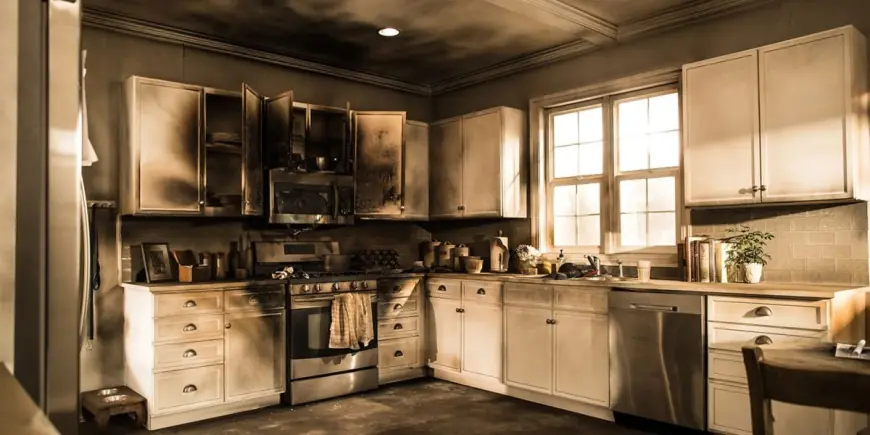Before You Replace Everything: Try These Smoke Damage Cleaning Tips First

Introduction: Stop! Don’t Replace It Until You Read This
If your home has recently suffered from a fire—even a small one—you’re probably overwhelmed by the sight (and smell) of smoke damage. That lingering odor, the dark stains, the feeling that everything needs to go... we get it. But before you rush to replace furniture, repaint walls, or toss clothes into the trash, take a breath. There are effective, affordable Smoke Damage Cleaning tips that can save you thousands of dollars and restore your belongings to their pre-fire condition.
In this post, we’ll walk you through 9 proven smoke damage cleaning tips and answer the most frequently asked questions homeowners have after a fire. From removing soot from your walls to deodorizing your favorite couch, we’ll help you clean smarter—not costlier.
Body: 9 Powerful Smoke Damage Cleaning Tips Before You Replace Anything
1. Understand What You’re Dealing With: What Is Smoke Damage, Really?
Smoke damage is more than just soot. It’s a complex mixture of carbon particles, acids, and chemical residues left behind after materials burn. These contaminants can:
-
Stain surfaces
-
Eat away at fabrics and paint
-
Embed deep into porous items like carpets, upholstery, and drywall
Quick stat: According to the National Fire Protection Association, U.S. fire departments respond to over 350,000 house fires annually. Even minor fires can cause thousands of dollars in smoke-related damage.
2. Act Fast — Time Is Not on Your Side
The longer soot and smoke sit, the deeper they penetrate. Within hours, metals tarnish, plastics discolor, and porous materials like wood and fabric absorb odors permanently.
Pro Tip: Begin cleaning within 24–48 hours of the incident for the best chance of restoring items.
3. Air It Out: Start with Ventilation
Before grabbing cleaning supplies, open all windows and doors to allow fresh air to circulate. Use fans and air purifiers with HEPA filters to remove lingering smoke particles from the air.
FAQ: “Will fresh air really make a difference?”
Yes—ventilation reduces air contamination and makes your cleaning efforts more effective.
4. Vacuum First — But Use the Right One
Use a vacuum with a HEPA filter to suck up loose soot and ash from carpets, drapes, and upholstery. Avoid vacuums with regular filters; they’ll blow smoke particles back into the air.
Important: Never rub soot into fabrics! Always blot or vacuum gently.
5. Use Dry-Cleaning Sponges for Walls and Ceilings
Also known as chemical sponges, these are specifically designed to lift soot without smearing. Wipe walls, ceilings, and other hard surfaces before applying any water-based cleaners.
Bonus Tip: Work in sections and clean from the top down to avoid spreading soot.
6. Neutralize Odors with Baking Soda and Vinegar
Smoke odors are persistent. Natural deodorizing agents like baking soda and white vinegar are inexpensive and effective:
-
Sprinkle baking soda on carpets and upholstery. Let sit overnight, then vacuum.
-
Place bowls of vinegar in rooms to absorb odors over time.
FAQ: “Do air fresheners work?”
Not really—they just mask the smell. You need something that neutralizes smoke molecules.
7. Wash Fabrics with Vinegar or Specialized Cleaners
Clothing, curtains, and linens can often be saved:
-
Use hot water, vinegar, and baking soda in your wash cycle
-
Consider smoke odor eliminators (available at hardware or restoration stores)
-
For delicate or expensive items, go to a professional cleaner experienced in fire damage
8. Tackle Hard Surfaces with Trisodium Phosphate (TSP)
TSP is a heavy-duty cleaner that works wonders on walls, tile, and appliances. Use gloves and follow instructions carefully.
-
Mix 1 tablespoon TSP, 1 cup bleach, and 1 gallon warm water
-
Scrub affected areas gently, rinse well, and dry completely
Caution: Always test a small area first to avoid damage.
9. Know When to Call the Pros
Not everything can or should be DIY’d. If your HVAC system is compromised, if there’s extensive structural damage, or if you’re dealing with toxic residue, hire a professional fire restoration company.
Stat to note: Professional restoration can salvage up to 85% of smoke-damaged items that most homeowners would discard.
FAQ: Your Burning Smoke Damage Questions—Answered
Q: Can I clean smoke damage myself?
Yes—if the damage is minor and localized. For larger-scale issues, especially those involving electrical or HVAC systems, professional help is a must.
Q: Is smoke damage dangerous?
Yes. Prolonged exposure to smoke particles can irritate the lungs, eyes, and skin, and may trigger asthma or other respiratory issues.
Q: How long does it take to get rid of the smoke smell?
It depends on the severity. Minor odors can clear in a few days with ventilation and cleaning. Severe smoke damage may take weeks and require deep cleaning or ozone treatments.
Q: Can I paint over smoke-damaged walls?
Only after proper cleaning and priming. Use odor-blocking primers like Kilz or Zinsser before repainting.
Conclusion: Save Big by Cleaning Smart
Before you empty your wallet on replacements, remember: smoke damage doesn’t always mean total loss. By acting quickly, using the right tools, and knowing what to clean (and what to toss), you can save your belongings—and your budget.
Use these tips as your smoke damage recovery roadmap. And if you’re ever in doubt, consult with a certified fire restoration expert who can help you make the call between cleaning and replacing.
What's Your Reaction?
 Like
0
Like
0
 Dislike
0
Dislike
0
 Love
0
Love
0
 Funny
0
Funny
0
 Angry
0
Angry
0
 Sad
0
Sad
0
 Wow
0
Wow
0

















































